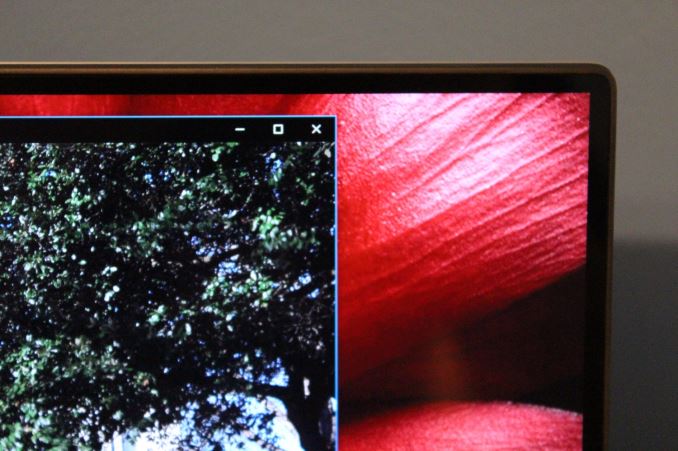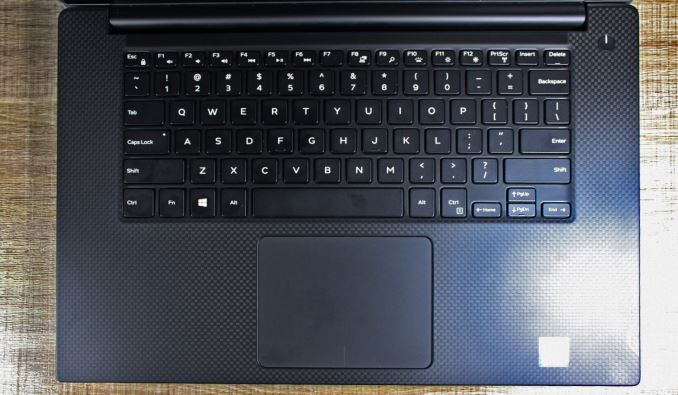The Dell XPS 15 9550 Review: Infinity Edge Lineup Expands
by Brett Howse on March 4, 2016 8:00 AM ESTDesign
There’s certainly some issues when competitors outright copy another’s design, but luckily for Dell they have one of the most appealing laptops already in the XPS 13. The XPS 15, other than the larger size, is extremely similar to its source of inspiration, and that’s a good thing. Moving to the Infinity Edge display brings the same strengths and weaknesses along with it, but the one thing you’d have a hard time knocking is the look of this laptop.
Dell uses CNC aluminum on the top and bottom of the laptop, which gives it that great cool feeling of metal when you are holding it in your hand. But open up the XPS 15, and you get to look at a soft touch carbon fibre weave which surrounds the keyboard deck. This soft touch material makes for a positive typing experience, and by going to black on the keyboard, Dell gets to avoid the contrast issues that happen on other machines with lighter colored keys. Although the laptop looks like a bit of a sandwich when its closed, I think the color scheme works very well and gives the XPS lineup a premium look.
The bottom of the laptop is as well thought out as the XPS 13. There’s a large vent for cooling, and the rubber feet are almost the entire width of the machine. There’s no issue with sliding around on a table top when you are using the XPS 15 thanks to these feet, and that’s not always something I can say about other laptops. It also gives you a nice stable platform in your lap. Another great XPS touch is that all of the FCC information, serial numbers, and other markings, are collectively put under an XPS badge on the bottom of the device to keep the look as clean as possible.
The left side of the laptop has the power connector, USB 3.0 Type-A port, HDMI, a USB 3.1 Gen 2 Type-C port which supports Thunderbolt 3 and power as well, and a headset jack. The right side has another USB 3.0 port, SD card slot, and a push button battery gauge. With the inclusion of USB 3.1 Gen 2 and Thunderbolt support there is a pretty big amount of bandwidth for any accessory, but as that market matures the USB Type-A connectors are likely going to see more use. It would have been nice to see a third USB port on the side but that’s a minor issue. Dell does sell a USB-C adapter which gives HDMI, VGA, Ethernet, and USB 3.0 all in one nice compact package which works well.
Once opened, the Infinity Edge display captures your eye, and the minimal bezel looks as good, or even better, than the smaller XPS 13. The webcam is still in a poor location though, tucked under the display and pointing up, which doesn’t flatter anyone. Considering the large bezel at the bottom of the display, I’d be fine with the screen shifting down slightly so the webcam could be fit above the screen, but I’m not a big user of a webcam so it’s not a big issue for me. If you do utilize a webcam a lot, this is not ideal and an external one might be better. I’d also like to see Windows Hello support in a premium machine such as this. Microsoft was able to fit it into the Surface Pro 4 and Surface Book with minimal bezels, so it can be done.
Taking a look at the keyboard, it’s very possible this is the exact same keyboard as on the XPS 13. It has the same white backlighting with high, low, and off settings, and the same layout as well. Dell didn’t try to squeeze a number pad into this 15.6-inch machine, and that’s a good thing since it would be very compromised with the smaller chassis this fits into. Key travel is 1.3 mm, which is adequate, and on the XPS 13 it was likely all that could be done thanks to the very thin body, but on the thicker XPS 15 I would have liked some more depth. The actuation force is also pretty light. The keyboard is ok but it’s not the best I’ve used, especially on a larger device.
Dell has gone with a Synaptics trackpad, and it is both very large and very smooth. Dell uses the Microsoft Precision Touchpad standard for their software, and although it lacks the outright customization of some of the other packages, in my time with the XPS 15 I found the touchpad to be excellent. The large size is very welcome, and it’s very precise while at the same time being very smooth. Two-finger scrolling works very well. There are not many options for three and four finger gestures with the Precision Touchpad, with three-finger tap opening Cortana, and four-finger tap opening Action Center. There are no other choices other than to swap those or disable it.
The overall design of the XPS 15 is as ground-breaking as the XPS 13 before it. By shrinking the bezels, Dell is able to fit a 15.6-inch device into a much smaller chassis, which makes it much more portable. The laptop itself is only 17 mm (0.66”) thick at its widest point (not including the feet) and weight with the 56 Wh battery is 1.78 kg (3.9 lbs) which is very light for a 15.6-inch machine. If you step up to the 84 Wh battery, that bumps the weight to 2 kg (4.4 lbs) which is still pretty respectable.















152 Comments
View All Comments
Ryan Smith - Monday, March 7, 2016 - link
We've checked, and there's only a single drive (and not a RAID device) present in the Windows device manager.Soac - Wednesday, March 9, 2016 - link
I don`t think I have explained correctly. The Laptop came setup in RAID mode on the BIOS, from the forums I saw that it happened to everyone, and yes this is for the 1 single drive 512 samsung m.2. Hence why I said it didn`t make sense. However, if you change the BIOS setting to AHCI the read speeds go up to 1.7Gbps.-----------------------------------------------------------------------
CrystalDiskMark 5.0.3 x64 (C) 2007-2015 hiyohiyo
Crystal Dew World : http://crystalmark.info/
-----------------------------------------------------------------------
* MB/s = 1,000,000 bytes/s [SATA/600 = 600,000,000 bytes/s]
* KB = 1000 bytes, KiB = 1024 bytes
Sequential Read (Q= 32,T= 1) : 1723.554 MB/s
Sequential Write (Q= 32,T= 1) : 600.373 MB/s
Random Read 4KiB (Q= 32,T= 1) : 0.000 MB/s [ 0.0 IOPS]
Random Write 4KiB (Q= 32,T= 1) : 0.000 MB/s [ 0.0 IOPS]
Sequential Read (T= 1) : 0.000 MB/s
Sequential Write (T= 1) : 0.000 MB/s
Random Read 4KiB (Q= 1,T= 1) : 0.000 MB/s [ 0.0 IOPS]
Random Write 4KiB (Q= 1,T= 1) : 0.000 MB/s [ 0.0 IOPS]
Test : 1024 MiB [C: 21.6% (102.8/476.4 GiB)] (x5) [Interval=5 sec]
Date : 2016/03/09 23:13:32
OS : Windows 10 [10.0 Build 10586] (x64)
Funny enough, someone was saying that in RAID mode the drive felt faster... so it would be cool if you could test it.
medi03 - Sunday, March 6, 2016 - link
Would be interesting to see how it fares at gaming vs amd's carrizo notebooks.iks - Sunday, March 6, 2016 - link
While this is surely a great piece of tech, with a superb screen, capable hardware, and decent, cooling I still wonder, what is the target audience of this and other similar devices? Have the guys over at Dell and other companies actually tried to do productive work that involves a lot of typing on this so-called "keyboard"? Especially programming? Using impossible to hit buttons with no proper spacing, a short F row, minuscule arrows and no dedicated page up / page down / home / end. Sorry, but a keyboard like that is just dumb, and a torture to use.nerd1 - Sunday, March 6, 2016 - link
Say that to millions of mac users. Apple's DESKTOP keyboard is even worse than this.BPB - Monday, March 7, 2016 - link
I am a developer, and I use a company issued Dell at work (decent specs). The keyboard doesn't matter to me since I dock it at work. At home I leave it closed and plug a monitor/keyboard/mouse into it. So why should I care? I do occasionally use it by itself, but I don't mind since it's not very often. I guess what I'm saying is, how many developers use a notebook without plugging in peripherals?iks - Thursday, March 10, 2016 - link
Well, I'm learning to use Vim to overcome button limitations on the different keyboards I may get to work on in future. People work on 60% boards after all.As far as plugging peripherals in / out, aren't you afraid of the ports coming loose over time?
jasonelmore - Monday, March 7, 2016 - link
I wanted to point out that the laptop on this article has different materials depending on if you get the 1080p version vs the 4k version.The 1080p version has a lot more plastic vs the 4k one.
nerd1 - Monday, March 7, 2016 - link
1080p version lacks the glossy glass (which I hate), but it is identical elsewhere.rstuart - Monday, March 7, 2016 - link
I own one of these, but I run Linux. Typical Linux issues - if enable the NVidia card it doesn't boot, and it will be because NVidia hasn't released drivers for it yet. I'm mostly a command line user, so that doesn't worry me overly. The Intel drivers causing the kernel to crash 2 out of 3 boots on the other hand drove me nuts. The latest kernel has fixed that thank god, so it's rock solid now. I was surprised to read people running Windows are having the similar issues - here I was putting it down to Intel's poor support for Linux. It's more of a case of Intel not having good drivers, at all, on anything. Be patient, and be forgiving of Dell - it's Intel's problem, not Dell's.Apart from the display, it works extraordinarily well out of the box. As a Linux user, this is not something I'm used to. On the down side, there is not much in the box as Dell hasn't got their act together yet accessories - mostly because of the change to USB-C.
The one thing I do question myself about is going with the UHD display. It is gorgeous. But according to Dell the HD display roughly doubles the battery life, and in reality eye candy fade but not having to worry about charging during the day would have been appreciated for a long, long time.
One other feature not mentioned in the review is everything (battery, WiFi card, DIMM's, HDD/SSD, fans for cleaning) is accessible with the removal of 8 or so easy to find screws on the back. Unlike some other makes, Dell laptops have been getting better in this regard over the years.